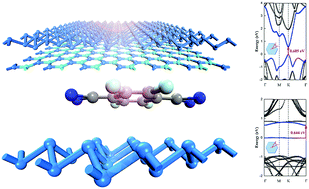Novel electronic structures and enhanced optical properties of boron phosphide/blue phosphorene and F4TCNQ/blue phosphorene heterostructures: a DFT + NEGF study†
Abstract
Blue phosphorene (Blue-p), an allotrope of black phosphorene, has attracted extensive interest due to its hexagonal crystal with a flat arranged layer of phosphorus atoms. However, the indirect band gap of Blue-p greatly hinders its applications in optoelectronics. By stacking both boron phosphide (BP) and the organic molecule 2,3,5,6-tetrafluoro-7,7,8,8-tetracyanoquinodimethane (F4TCNQ) with Blue-p, we construct BP/Blue-p and F4TCNQ/Blue-p heterostructures. We reveal that the BP/Blue-p heterostructure possesses a direct band gap of 0.605 eV and is tunable via in-plane strain and an external electric field. Moreover, it also has remarkable optical absorption in the UV region and enhanced transport properties. Furthermore, by doping with F4TCNQ, the F4TCNQ/Blue-p heterojunction displays type-II semiconducting properties with a flat valence band and Van Hove singularities at the Fermi level, which can be used to achieve extremely low in-band tunneling, yielding low static power dissipation and large drive currents in the ON regime of transistors. Due to the superior electronic, optical and transport properties, Blue-p-based heterostructures are promising candidates for electronic and optical device applications.



 Please wait while we load your content...
Please wait while we load your content...